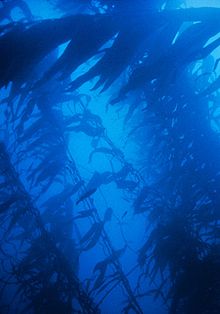Monterey Bay
Monterey Bay is a bay on the Pacific coast near the eponymous Californian town of Monterey . In a narrower sense, it only refers to the actual bay between Santa Cruz in the north and Monterey in the south with a diameter of a little over 40 km, but the waters around the entire Monterey peninsula that adjoin it to the south are often also included. The 1992 designated Monterey Bay National Marine Sanctuary , a marine sanctuary named after the bay of the US federal government covers large parts of the central California coast and extends from Marin , north of San Francisco in the north toCambria , south of Monterey. It covers 445 km of coastline and almost 15,800 km 2 .
geography
The bay is located on the central coast of California, around 120 km south of San Francisco. The Salinas River and the San Benito River originally flowed into the bay . Both are tapped for irrigation of agricultural land and their river beds hardly have any water at the mouth and often fall completely dry. The mouth of the San Benito River is a swamp area that is a protected nature reserve as the Elkhorn Slought National Estuarine Sanctuary . Because of the low input of river water, the salinity of the brackish water increased .
Most of the bay falls flat to a maximum of 30 m, but in the center of the bay, as an extension of the Elkhorn Slought, begins the Monterey Canyon , a submarine gorge that extends over 150 km into the Pacific and a depth of about 3600 m reached.
Habitats

The California Current carries large amounts of cold, nutrient- and oxygen-rich deep water into the bay through the Monterey Canyon . This is why an extraordinarily species-rich kelp forest has developed in the region .
The kelp forests are among the most biodiverse marine areas in the world. Over 1000 different species live there. In addition to the giant algae of up to 70 m in size from the Laminariales class, these include numerous species of plankton , mussels , crabs , sea slugs , seahorses , wrasse , rock perch , rays , sharks , sea urchins , octopuses , starfish , squids , abalones , sea anemones , Sponges and many more.
Numerous marine mammals such as bottlenose dolphins , seals and elephant seals also benefit from the kelp forests . The sea otters are noticeable . Humpback and gray whales visit the bay on their migrations. There are also many water birds.
The bay is home to the Monterey Bay Aquarium Research Institute , a major marine research facility.
history
Juan Rodríguez Cabrillo was the first European to discover the bay on November 16, 1542 during an expedition of the Spanish Navy. He named it Bahia de los Pinos , possibly because of the Monterey pine forests . The current name of the bay was first mentioned in 1602 by Sebastián Vizcaíno , who was commissioned to draw a detailed map of the coast. He anchored at what is now Monterey Harbor and named the point Puerto de Monterey in honor of the Count of Monterrey .
Monterey became the seat of the Spanish governor of Alta California and the largest military garrison. From their supply, fishing in and in front of the bay developed into the economic basis of the region. Initially it was whaling , but from the 19th century the bay's huge swarms of sardines became important for the population. With the advent of the tin can at the end of the 19th century, fish could be preserved for longer periods of time and thus sold and exported nationally. In the 20th century, the fishing methods became more and more sophisticated, the fishing vessels bigger and bigger. The peak fishing season on Monterey Bay is described by John Steinbeck in his novels from the 1930s to 1950s. The cyclically fluctuating stocks of sardines were so severely depleted during World War II, especially for the rations of the US Army , that the shoals and the fishing industry collapsed in the 1950s.
tourism
The tradition of fishing, immortalized in the stories of John Steinbeck, became the region's new economic base after the collapse of the sardine stocks in the form of tourism. Cannery Row , described in Steinbeck's novel of the same name, is now the entertainment district of the city of Monterey. Tourism in Monterey and the region relies heavily on the bay. Most of the beaches are designated as State Beaches or State Parks .
An attraction related to the bay is the Monterey Bay Aquarium , one of the largest show aquariums in the world. It only shows animals and habitats from the region, from the shore area to the shelf sea off the coast. At the same time, research and nature conservation projects are based at the aquarium.
The bay is a first-class diving area for cold water dives because of the biodiversity . Numerous diving schools and bases offer courses and guided dives . Diving has a long tradition, especially in Monterey, where people dived decades ago because of the sardine fishery. Various types of whale watching are also offered in the bay and its surroundings . The main season for observing gray whales , humpback whales and killer whales is from late December to April.
Web links
- NOAA: Monterey Bay National Marine Sanctuary (official site, English)
supporting documents
- ↑ Monterey County Weekly: The modest little fish - and Monterey icon - contains grand teachings on how to manage fish populations. 1st of January 2014
Coordinates: 36 ° 47 ′ N , 121 ° 58 ′ W

